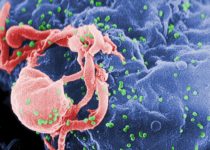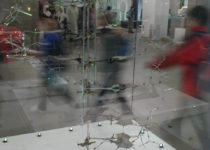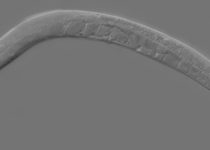The Intriguing Origin Of Van Der Waals Force Makes Us Rethink The Nature Of Nothingness
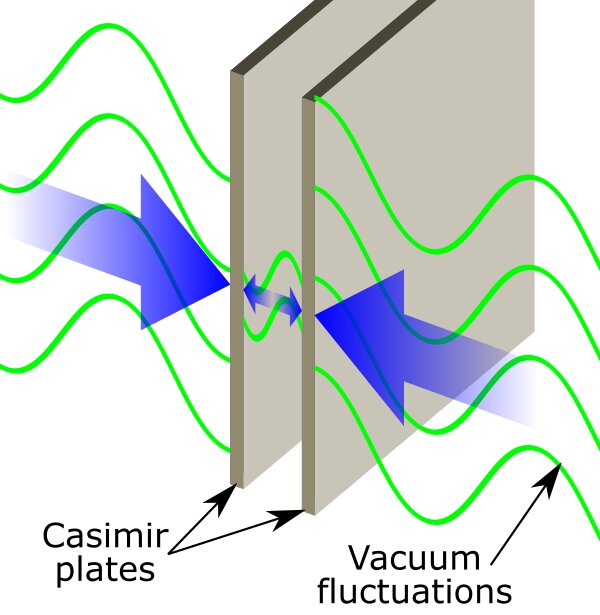
Van der Waals force (also called Casimir force) is a distance dependent attractive force that is felt by atoms and molecules when they are vary close. It is much weaker than the attractive forces of covalent and ionic bonds. But its significance for various phenomena is immense. Wikipidia summarizes the far ranging influence of van der Waals force in the following words.
Van der Waals force plays a fundamental role in fields as diverse as supramolecular chemistry, structural biology, polymer science, nanotechnology, surface science, and condensed matter physics. It also underlies many properties of organic compounds and molecular solids, including their solubility in polar and non-polar media.
Source
What I find the most fascinating about van der Waals force though, is its origin. Because it forces us to reassess the way we perceive vacuum, space, and nothingness. Here, I will first give a very brief and simple explaination of how van der Waals force comes into being, and for those of you interested in technical details, I will follow it up with a more detailed explanation.
Simplified Explanation
A layperson still thinks of vacuum as the complete absence of any matter. But quantum mechanics tells us that that’s not true. In fact, one of the bizarre conclusions of quantum mechanics is the concepts of virtual particles and zero point energy. According to these concepts, vacuum is not empty, but teeming with subatomic, elementary particles, like photons, electrons, positrons, neutrinos and many others constantly popping in and out of existence. These elementary particles are millions of times smaller than even atoms. An electron’s mass for example, is so small that it is essentially neglected when calculating the total mass of an atom.
These elementary particles that briefly come into existence out of nothing are called virtual particles. And the energy they have is called zero point energy. In other words, empty space is not like the blank screen of a TV when it is switched off. Its like TV static with its black and white spots constantly appearing and disappearing. And physical objects are akin to a movie on TV. In that sense, empty space is not exactly empty. In fact, these virtual particles are an inherent property of space.
By the way, the fact that virtual particles just come into existence out of nothing is not a violation of the law of conservation of energy and mass. Because these subatomic particles pop in and out of existence as particle-antiparticle pairs. Every time a particle comes into existence, its antiparticle also comes into existence with it. A photon is always accompanied by an antiphoton, a nutrino is always accompanied by an antinutrino, and so on. A particle-antiparticle pair is very much like 1 and -1 in their relationship- together, they are equivalent to zero. After popping into existence, the particle very quickly merges back into its antiparticle and they both cease to exist again.
So how do these virtual particles constantly popping in and out of existence give rise to van der Waals force? The answer lies in Casimir effect. This is a phenomenon in which if two plates are brought extremely close together, quantum mechanical principals (that I have elaborated on in the detailed explanation below) dictate that the space between them is too small for many of the virtual particles to pop into existence.
This means that at this point, the number of virtual particles popping into existence around the two plates is more than the number of virtual particles popping into existence between the plates. This means that the density of these virtual particles between the plates is less than their density around the plates, which creates a net pressure by the extra virtual particles around the plates that pushes the plates closer together until they touch each other. This pressure, in a nut shell, is van der Waals force. And because virtual particles are an inherent property of space, when an object experiences van der Waals force, its essentially experiencing the weight of empty space!
A perfect analogy of this phenomenon in daily life can be seen in how suction cups work. The reason why a suction cup sticks to wall is that on pressing it, you push much of the air between the suction cup and the wall out, making air density between the suction cup and the wall less than the air density outside. This allows the atmospheric pressure to act on the suction cup, pushing it against the wall. So when you try to pull this suction cup off the wall, you are fighting against atmospheric pressure. Here, the air density difference is the analogue of the virtual particle density difference that gives rise to Casimir effect and van der Waals force.
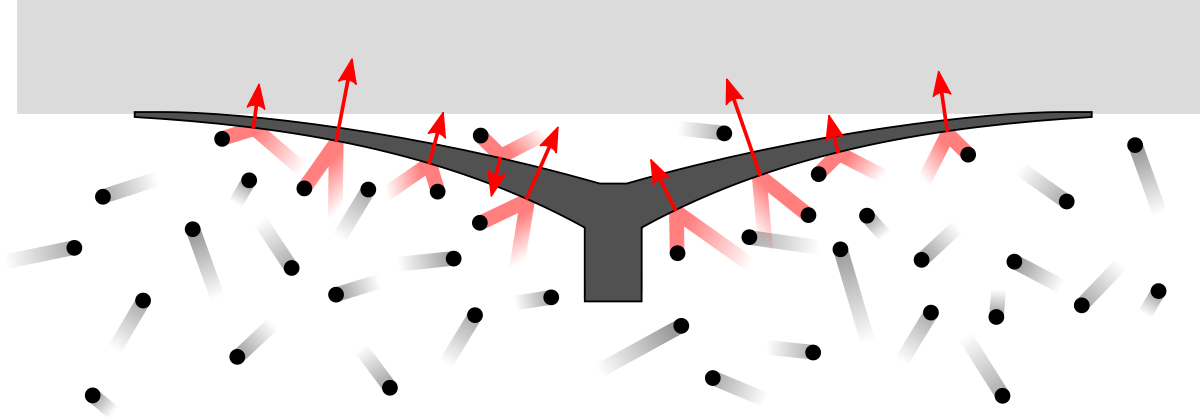
Detailed Explanation
So, why do virtual particles and zero point energy exist to begin with? The explanation lies with wave particle duality, complementary principle and Heisenberg’s uncertainty principle. A full elaboration of wave particle duality would require a separate post in itself. All that we need to understand in context of Casimir effect is that according to this hypothesis, there are no pure particles or pure waves. Every particle has some characteristics of a wave and every wave has some characteristics of a particle.
This is not apparent at macroscopic scales. But it rules everything at the quantum level. Wave particle duality is summarized by de Broglie’s principle. This principle states that if p is the momentum of a particle and h is plank’s constant, then the wavelength λ associated with wave nature of that particle is given by the relation:

The exact value of plank’s constant is h = 6.62607015×10−34 J⋅s . As you can see, this is an incredibly small value. And this is the reason why the wave nature of macroscopic particles of our daily life, like marbles and rocks, is too small to be noticeable. The momentum of a moving marble, for example, is way too large compared to plank’s constant. So as per de Broglie’s equation above, the wave length λ associated with the marble would be negligibly small.
The momentum of an elementary particle like electron, on the other hand, is so small that the difference between it and the value of Plank’s constant would not be too much. This means that the wavelength λ associated with the electron would be noticeable, and hence its wave nature would have real effects on its behavior. This holds true for all other elementary particles, and is central to understanding the origin of virtual particles.
To understand why some virtual particles don’t pop into existance between the two plates if they are too close together, let’s first understand a phenomenon related to the wave nature, called resonance. Hang a cell phone charger from your hand and swing it like a pendulum. Notice that to swing it properly, you must move your hand a specific number of times per minute. If you move it more or less frequently then that then the charger will stop swinging. This phenomenon is called resonance. The number of times you move your hand per minute is called frequency. And the charger swings maximally at a specific frequency because that’s its natural frequency of oscillation.
Now, if you change the length of the wire between your hand and the charger by holding it from closer or further away, then the charger will no longer swing maximally at the previous frequency. You will have to swing it at a different frequency to make it swing maximally again. This is because the natural frequency of oscillation of the charger changes with the length of the wire between it and your hand. The charger in this case is basically a pendulum. Every object has a natural frequency of vibration, or the number of times it will vibrate per second.
If you try to vibrate it at this frequency it will vibrate. But of you expose it to vibrations of other frequencies it will not vibrate. Resonance is a phenomenon associated with waves because waves are nothing but oscillations. Every virtual particle also has a natural frequency associated with it. Just like different cellphone chargers would have different natural frequencies depending on the lengths of their wires, different virtual particles also have different natural frequencies depending on their types.
Now, imagine that while swinging the charger, you hold the wire from the middle with your other hand, with your swinging hand on one end of the wire and the charger on the other end. Now you obviously won’t be able to swung the charger because its movement is obstructed by your second hand holding the wire. The distance between the charger and your holding hand is analogous to the distance between the two plates in Casimir effect. And the distance between the charger and your swinging hand is analogous to the distance in space a particular virtual particle would need to oscillate and therefore come into existence.
This means that if the distance between charger and your swinging hand is more than the distance between charger and your holding hand, then the charger won’t swing as your holding hand would obstruct the wire. However, if distance between charger and swinging hand is less than distance between charger and holding hand, then you can still swing the charger. Because the holding hand will no longer be between the charger and swinging hand, leaving the wire to freely swing. However, at this reduced length of wire, natural frequency of the charger will have changed due to change in length of the wire.
In context of Casimir effect, this means that if the distance between plates is larger than the wavelengths (or natural frequencies) of all the virtual particles, then all virtual particles can pop into existence between plates. But if the distance between the plates is more than the wavelengths of some virtual particles but less than the wavelengths of others, then the virtual particles whose wavelengths are more than the distance between the two plates won’t be able to pop into existence between the plates. In fact, a macroscopic analogue of Casimir effect can be demonstrated using water waves and two large plates, as shown in the video below.
Complementarity principle was formulated by Niels Bohr, and states that objects possess certain pairs of complementary properties that cannot be observed or measured simultaneously. These pairs include position and momentum, energy and duration, spin on different axes, wave and particle related properties, value of a field and its change, and entanglement and coherence. Heisenberg’s uncertainty principle states that there is a fundamental limit to the precision with which values of two complementary variables can be known simultaneously, and this limit is equal to half of reduced Plank’s constant.

This uncertainty in measuring both complementary variables simultaneously isn’t just due to limitation of our instruments. Its a fundamental property of our universe, written in stone just like other fundamental laws of physics. Its IMPOSSIBLE to accurately measure both complementary variables simultaneously, no matter how precise and efficient our instruments are.
One such pair of complementary variables is energy and time duration. In other words, there is a fundamental limit to the precision with which energy at any point in space, and the time duration of that energy, can be known. It is this uncertainty regarding energy and time duration that leads to the continuous quantum fluctuations in empty space, and it is from these quantum fluctuations that virtual particles originate.
Van Der Vaals Force And Biomolecules
One of the most significant roles of Van der Vaals force is in helping certain protein molecules bind to each other. What comes into play here is shape complementarity. Molecules we encounter outside body, like oxygen, water and carbon dioxide, consist of only a handful of atoms. A protein molecule on the other hand, can contain hundreds and hundreds of carbon, oxygen, hydrogen, nitrogen and sulfur atoms, making them truly giants in the world of molecules. This large size means the surface area of protein molecules is also large. And this is where Van der Waals force comes into play.
There are tens of thousands of different protein molecules in the body. And all of them have different shapes and sizes. If the shape of two proteins is not complementary, then they can’t fit neatly into each other. If on the other hand, their shapes are complementary, then they neatly fit into each other. You can think of them like two neighboring pieces of a jigsaw puzzle, with complementary shapes.
Now, when they neatly fit into each other due to their shape complementarity, the distance between their surfaces gets short enough to prevent formation of some virtual particles in the space between them. This is when Van der Waals force comes into play, as the virtual particle density in the space between the two protein molecules gets less than that in the space surrounding them, creating a net pressure that pushes the two proteins close to each other, binding them. Just like a suction cup gets adhered to the wall due to atmospheric pressure.
On the other hand, if the shapes of proteins are not complementary, then even if they come close together, the distance between their surfaces is not short enough to prevent formation of virtual particles. This prevents Van der Waals force from acting on them. Vander Waals force, therefore, helps make protein protein interactions more specific, by binding together proteins whose shapes are complementary, and not proteins with non complementary shapes.
To summarize, lets look at the video above once again, in which the macroscopic analogue of Casimir effect is demonstrated using two metal plates in a liquid. The metal plates are the equivalent of two protein molecules with complementary surface, the liquid the plates are in is the equivalent of empty space. And according to quantum mechanics, empty space isn’t like the absolutely still liquid at the start of the experiment. Its like the continuously agitating liquid later in the experiment. The energy being used to agitate the liquid is equivalent to the zero point energy that empty space inherently possesses.
The waves generated in the liquid due to the energy are equivalent to the quantum fluctuations in empty space caused by zero point energy. Quantum fluctuations that are otherwise called virtual particles. Just like the two metal plates are brought close together by the unequal distribution of waves in the liquid, the two protein molecules with complementary surfaces would be brought together by unequal distribution of quantum fluctuations or virtual particles. And the force that would bring the two protein molecules together is called the van der Waals force.
Van der Waals force, therefore, is a result of the fact that the nature of empty space, or nothingness, is dramatically different than what most people think. Vacuum is not nearly as empty as we might think. It inherently possesses zero point energy, which is inseparable from it and is the origin of van der Waals force. And this lack of emptiness is central to our own nature, including how the biomolecules inside our body interact.
